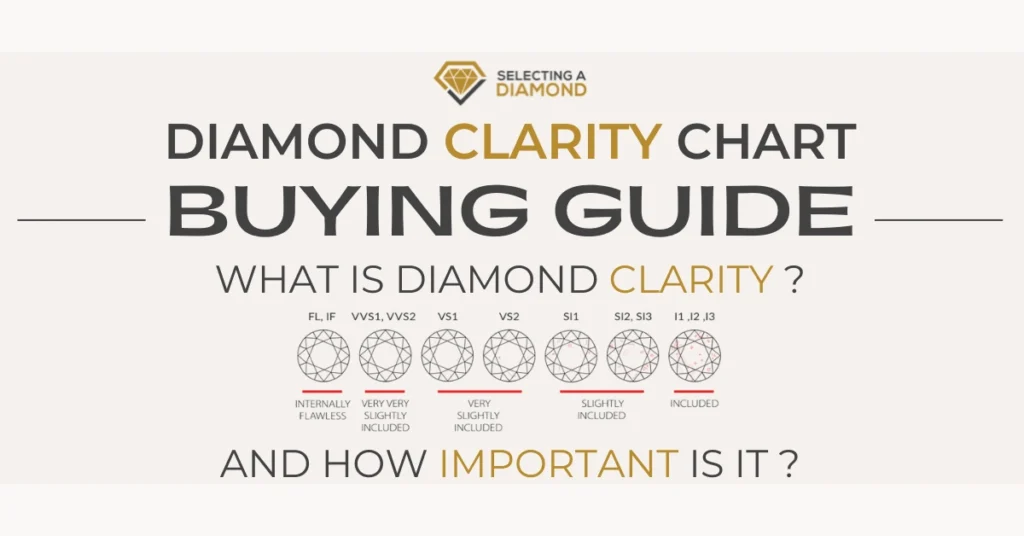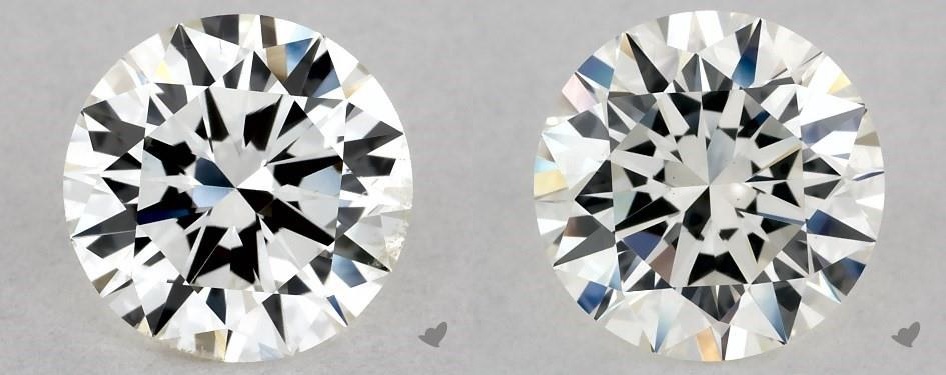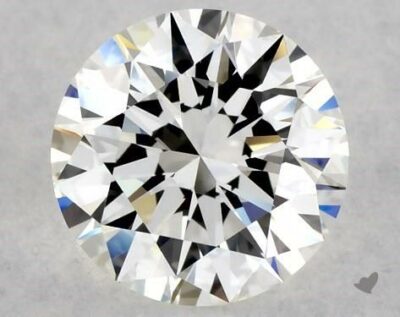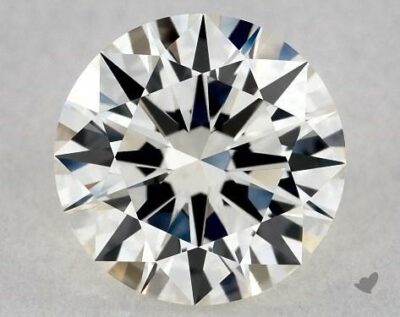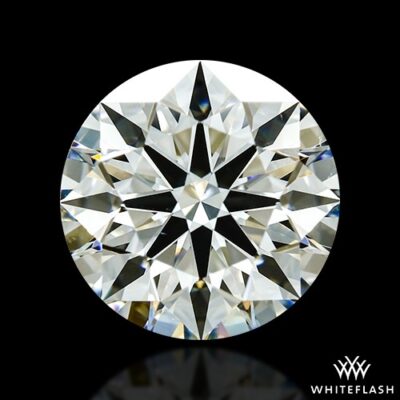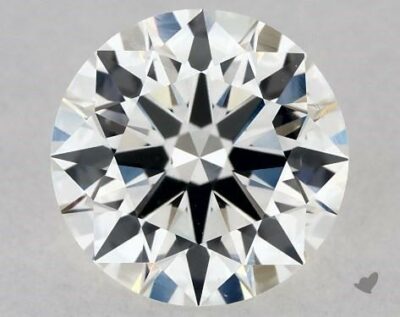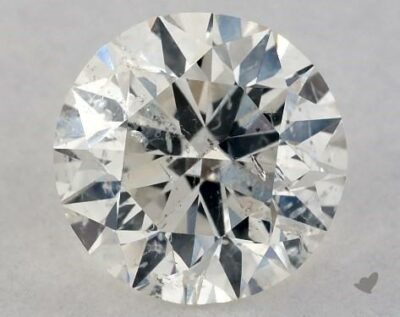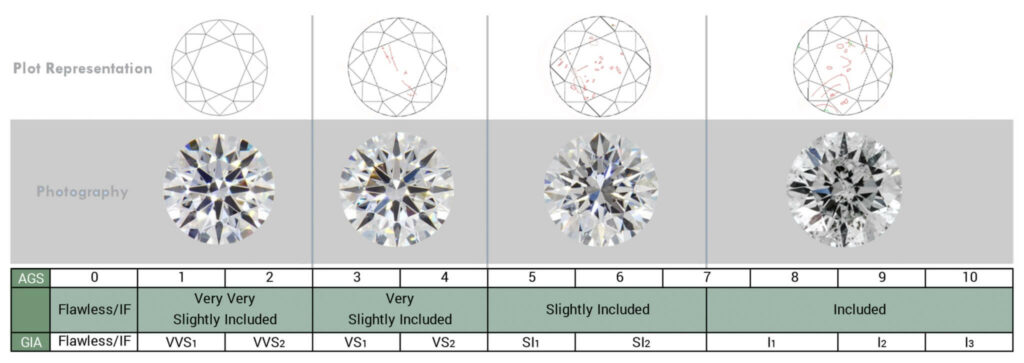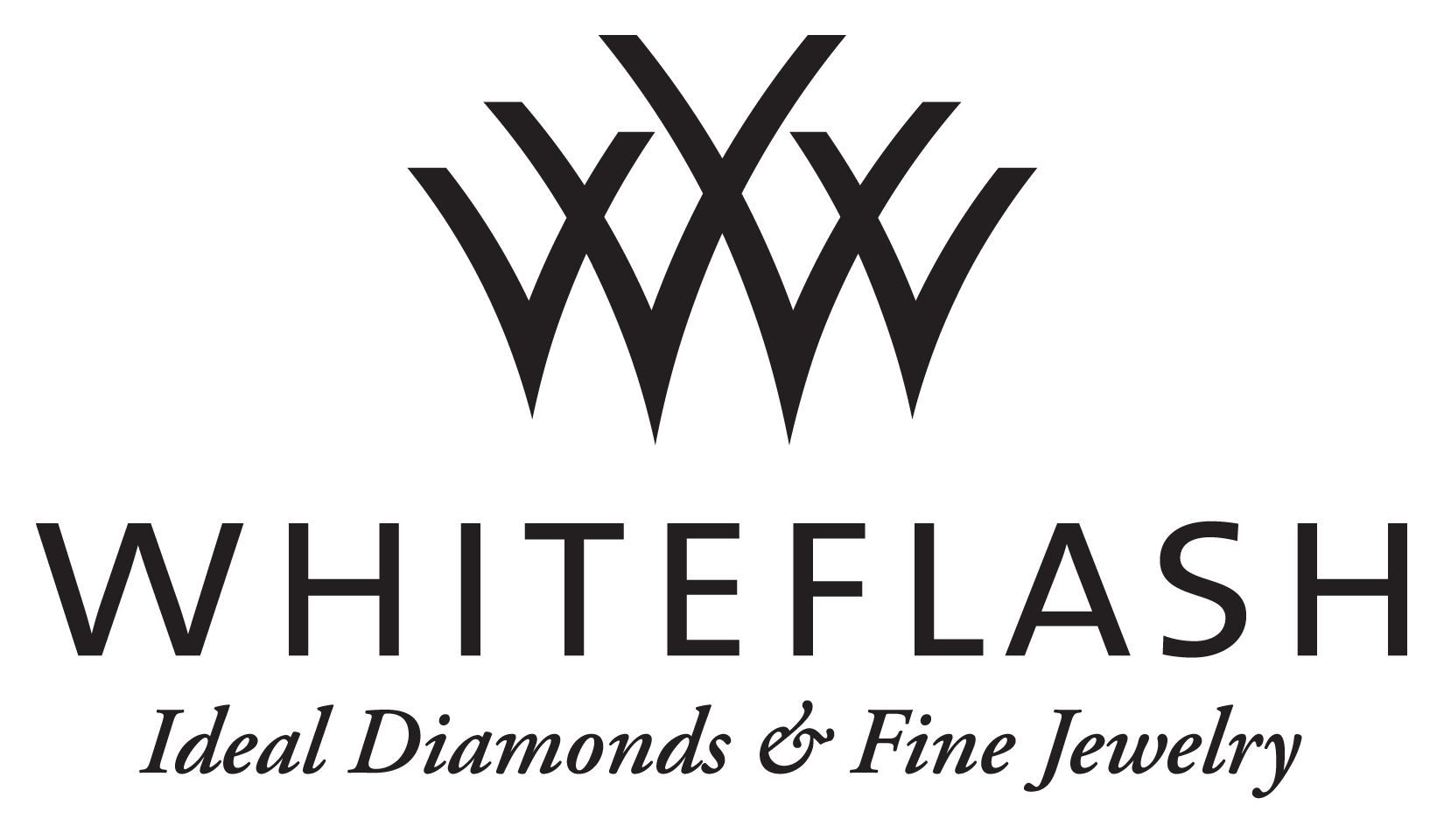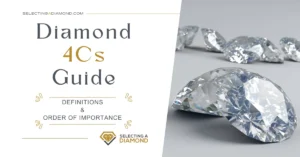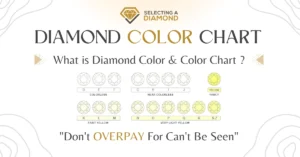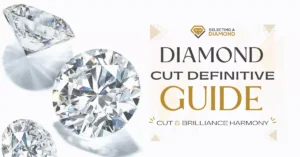Summary in a few lines:
Clarity is a pillar of Diamonds 4Cs (along with Cut, Color, and Carat), the most important factor in diamond clarity is not getting highest grade possible, but to guarantee an eye clean grade.
Diamond Clarity Scale/Chart (as defined by GIA) is segmented into 6 groups & 11 grades, from FL-Flawless (cleanest and most expensive), to I3-Included 3 (visible inclusions included, cheapest and lowest quality).
Most diamonds fall into the VS (very slightly included) or SI (slightly included) groups.
Guaranteeing an eye clean diamond is achievable with an SI1 grade, or VS2 in higher carat diamonds, here is a great eye clean SI1 diamond on James Allen, you can also check this stunning VS2 diamond on Whiteflash to see how great these grades are.
You shouldn’t spend too much to get flawless or even VVS grades, since (compared to price) you won’t notice any difference.
Let’s break down all this.
Overpaying for a diamond with specs/characteristics that doesn’t really make a difference in the sparkle and brilliance of a diamond is a rookie mistake that we would like to help you avoid!
The diamond business is a tricky one. It’s easy for inexperienced diamond shoppers to get ripped-off, luckily, we have websites that teaches people how to pick great diamonds at any budget, and how to get the most bang for the buck!
A lot of people can’t really differentiate between what really concerns them and what is better described as marketing hype, for cut, we know that in order of importance, Cut is the winner among 4Cs.
For carat, it’s a matter of preference, and we also have visual images showing what are the actual sizes on hand for different carat.
This leaves us with the two most common issues, revolving around diamond clarity and diamond color.
A lot of people lacking the real understanding jump in and end up spending way too much money for characteristics that won’t have much effect on their stone, like getting a superior high clarity grade!
For example, in diamond color, you might hear this many times from jewelers that you have to go high (like getting a D or E color grade) to guarantee a colorless diamond, but there nothing could be further from the truth, not even an F grade is always needed!
In short, you can be safe and guaranteeing a colorless diamond by getting a G color diamond!
Let’s take a step back, what does diamond clarity actually mean?
What is Diamond Clarity?
Diamond clarity is a measure of how “clean” the diamond is.
Diamonds are basically natural minerals, therefore it’s a given to often have a certain amount of imperfections in them, such as small chips, feathers or clouds, which may or may not affect the perceived beauty and sparkle of the gem.
By the way, even Lab-Grown Diamonds have inclusions, so it’s not the case only for mined diamonds.
In many cases, these imperfections (referred to as inclusions/blemishes) are so small or they’re located in places that have almost NO material effect on the stone’s brilliance!
Pro Tip: It’s becoming very common among people, jewelers, and websites to refer to any imperfection on the diamond as “inclusion”, and we see it’s worth to highlight the main difference between inclusions & blemishes:
Inclusions are these birthmarks which are internal (haven’t reached the diamond surface), while blemishes are -obviously- external birthmarks (on diamond surface).
How Important is Diamond Clarity?
With that being said, diamond clarity is only one pillar of four. All 4Cs need to be taken into consideration when making a decision about a gem.
When it comes to diamond clarity, you really need to understand what you are looking for in order to make the right call and get your money’s worth; buying the best diamond there’s for your set budget!
For example, here are two diamonds we found on James Allen:
The left one is this 1 carat, H color, Excellent Cut, SI1 Diamond (in case it got sold, it was priced at $4,280), and the right one is this similar diamond but VS1 ($5,520).
By keeping in mind that these diamonds are magnified (20x their real size), are you able to tell if there is a difference in clarity?
The two diamonds you just saw are both EYE-CLEAN. Differences between each of them are almost microscopic; you can never really see any inclusion on the first diamond by inspecting it with your eye.
What if I told you that in terms of light reflection & brilliance, when you avoid specific inclusion types, there won’t be much of a difference, wouldn’t that make you think:
Why I want to pay $1300 extra for this clarity upgrade?
Yet, having said that, this is the reason why it’s very important to understand what diamond clarity is, and how it’s measured!
And to which extent should you care about diamond clarity? Should you always shoot for the highest clarity? Or does a safe “grade” exist when talking about diamond clarity scale?
Diamond Clarity Chart (Scale)
Looking online on sites such as James Allen or Blue Nile, you will see that clarity is referred to by a letter code, on a scale ranging from FL (for Flawless) diamond to I3 (for included, i.e. visible inclusions to naked eye).
This scale letters refer to the overall severity of the natural flaws of a diamond when examined under a 10x magnification, it’s very important here to highlight that 10x magnification being the standard, meaning that when they say slightly included, they mean this when seen under 10x not with naked eye.
A diamond might have several small non-visible inclusions but still, get an SI1 rating just because it has a high number of inclusions!
On the other hand, you might find a VS2 with only one inclusion! But which of course won’t be recommended because of it being black dead center of the table facet of the stone! So you can’t just rely on the count of the diamond inclusions to decide.
In a nutshell, diamond clarity scale/grades are the results of the cumulative number and harshness of inclusions on the stone.
GIA Diamond Clarity Grading
To decide a clarity grade, GIA considers the size, nature, position, color, and quantity of inclusions visible under 10× magnification (i.e. not to naked eye).
The guidelines followed by GIA are strict, really strict, and this is one of the reasons why GIA is the best certification lab out there.
In a bit of visualization, here is how diamond clarity chart looks like:
Because they are usually mentioned together, we think it’s also important to review our Diamond Color Chart.
Let’s see what differentiates a clarity grade/group from the other, as defined by GIA Clarity Standards:
1. Flawless – FL
Flawless, no inclusions under 10x.
2. Internally Flawless – IF
None or only insignificant surface blemishes and no inclusions when examined under 10x. Normally, most blemishes can be removed by minor polishing.
Anything that appears to be an inclusion on an FL-IF diamond is probably dust or at worst a speck that can be polished out easily. If there were a true inclusion, even a tiny one, diamond grading labs would give the diamond a VVS1 grade and not IF.
Browse FL-IF diamonds on James Allen.
3. VVS Range – VVS1/VVS2
Very Very Slightly Included, contains minute inclusions that are extremely difficult for an experienced grader to locate under 10x magnification.
What generally separates a VVS2 from a VVS1 are the number of these small specs, VVS1 might have a small inclusion at 3:00 and a VVS2 might have one at 3:00 and another at 9:00. This makes no difference to anyone looking at the diamond without strong magnification as both are too small to be seen even with a standard loupe.
Browse VVS1/VVS2 diamonds on James Allen with our preset filters for recommended diamond characteristics.
4. VS Range – VS1/VS2
Very Slightly Included, contain minor inclusions that range from difficult to somewhat easy to see under 10x magnification. Typical VS inclusions are small crystals, feathers, or distinct clouds.
In 99% of the cases VS2 diamonds are clean to the naked eye. The other 1% (or less) are rare cases like very high carat diamonds with a black inclusion in center on the table.
Browse VVS1/VVS2 diamonds on Whiteflash.
5. SI Range – SI1/SI2
Slightly Included, inclusions are noticeable under 10x magnification to an experienced gemologist and might be visible with the unaided eye, “might be” because most of SI1 diamonds are eye clean and no inclusions are visible to naked eye.
This diamond cut is superior, learn more about True Hearts.
With SI1 being our recommended clarity grade to start with, browse thousands of eye clean diamonds on James Allen here.
6. I Range – I1/I2/I3
Included: Diamonds with obvious inclusions, these inclusions may even affect transparency and brilliance of the diamond.
We don’t recommend browsing any diamonds in this range, anywhere.
So in a nutshell:
Always seek eye clean diamonds, this is not exclusive to FL-IF, VVS range, and VS1.
SI1 & VS2 are safe and we always recommend not spending on higher grades, VS2 is recommended for higher carat (+1.2 generally).
Stay away from I range, they have obvious inclusions, and because these aren’t desirable, you will see that reputable stores stops before I3.
For example: James Allen stops at I1:
And as we saw in our Blue Nile Review, they even stop at SI2:
We encourage as well to read our Full Review & Comparison between James Allen Vs. Blue Nile
As you can imagine, the price of a diamond will vary tremendously upon a change in its clarity, we saw above the difference between SI & VS groups, going to VVS or even Flawless will drive anyone crazy.
This all comes down to our overall recommendation of buying online from reputable vendors, for a lot of reasons we saw in our James Allen Review; like the ability to see the diamonds for yourself in 360 degrees and 20x magnification (they even introduced 40x magnification!).
Is GIA Clarity Chart Standard Across the Industry?
It’s also worth mentioning that there are no universal guidelines for determining clarity.
Each diamonds certification lab has its own guidelines for diamond clarity grades, we saw above that GIA grades from FL to I3, but for example, AGS grades differently.
AGS Clarity Chart
On AGS certificate, you will see a number from 0 to 10, where 0 means very pure (Flawless/Internally Flawless), and 10 equals I3 in GIA terminology.
It’s pretty nice to see that AGS uses GIA referencing to different grades (not only in clarity, but in cut & color as well) on their site, so the reader is well-educated about their choices & differences, this is the clarity chart as seen on AGS website:
IGI Clarity Chart
IGI uses very similar grading chart for GIA, except they don’t have a Flawless grade, just Internally Flawless (same as AGS).
Before getting an IGI diamond, we encourage you to read our IGI vs GIA review to make an educated decision.
EGL Clarity Chart
For EGL, we wish there is any official reference for EGL that we count on, every office in the world starts their own “EGL-You Name It” and start grading diamonds, maybe we should buy a loupe and start an EGL office?
That’s why we NEVER recommend getting an EGL diamond as we saw in our review.
You see why the certificate is very important aspect of your purchase journey, some people consider it the 5th C.
That’s why you have to make sure the diamond certificate -for the stone you are interested in- is from a trustworthy lab (mainly GIA or AGS labs).
Diamond Clarity Grades Prices
Always remember, diamond clarity is rated based on a 10X magnification.
This means that -unless you are looking at an SI2 diamond or lower- inclusions will not be visible to the naked eye and most likely will not affect the reflection of light through the diamond, which is what gives it its sparkle and beauty.
In general, with all diamond other characteristics being constant, it’s recommended to look for a diamond in the SI1-VS2 range of clarity; which will offer the best value for money invested.
Pro Tip: If you’re looking for higher carat (1.2 and more), it’s recommended to stick to at least VS2 since inclusions might be more visible in larger diamonds.
Let’s fix these characteristics, and then look at price range for each clarity grade group:
Cut: Excellent
Color: G
Carat: 1
Polish & Symmetry: Excellent
Fluorescence: None
And because diamond certification is crucial, all will certified by GIA.
Among our top retailers, we believe James Allen offers the best prices with a great collection even with all these characteristics constraints, so we will be using price ranges from JA
FL-IF Prices
As mentioned, these grades are extremally high, that even a lot of jewelers have never even seen one, so we only have 15 diamonds on JA within this range for the above characteristics.
Price ranges from $9.5k to $10.2k for 1 carat diamond, which is almost DOUBLE the price of a great 1 carat diamond.
VVS Prices
Out of 267 diamonds, we saw prices ranging from $8k to $9.8k.
VS Prices
Much more options, we have 528 diamonds with prices as low as (excluding outliers of course) $6.4k up to $9.4
SI1 Prices
Since SI1 is an important grade and differentiates eye clean diamonds from not (in SI2 and lower), we will check their prices separately.
Out of 320 diamonds, we see a price range between $5k and $7.1k
SI2 Prices
We mentioned that we don’t recommend this range (and I1-I3 as well), but let’s see the price drop when you move from an eye clean range, to somewhat visible inclusions.
James Allen offers 406 SI2 diamonds, from $3.5k to $5.6k
Note that the price drop between SI1 & SI2 is for 1 grade only, not like VS to SI1 since price will cover VS1 & VS2 in that group.
That’s why we see a drop of $1.5k in prices when you go from an SI1 to SI2.
All these prices were for round diamonds, if you’re interested to learn more about this, we encourage you to read Diamond Cut vs. Diamond Shape & Most Popular Shapes post.
Summary: Don’t Get Ripped-off on Diamond Clarity
Diamond clarity is an important characteristic of a diamond, however, watch out for some jewelers that will try to oversell you!
It’s critical to pay close attention (and more money for that matter) to other more important factors, mainly the Diamond Cut.
Once you’re all set on the rest of the factors, get a diamond with SI1 clarity and you’ll be safe (VS2 if carat is above 1.2), none of the inclusions on the diamond will be visible to the naked eye.
BUT, be careful, make sure that these very minor inclusions aren’t black or located dead in the center of a diamond table facet (top of the diamond).
Still not sure where to buy your diamond?
We always recommend shopping diamonds online and created a Full guide to shop diamonds like a Pro.
Among online retailers, here are our favorite stores click their logo to visit store
-
James Allen:
Our favorite online store, best diamond imaging technology available today, comes with the largest collection with more than half a million loose diamonds.
-
Blue Nile:
Widest collection of loose diamonds of all sizes, great imaging technology for most of their inventory (hundreds of thousands of diamonds), great customer support.
-
Whiteflash:
Home Of A CUT ABOVE® Super Ideal Diamonds, they stand out from the crowd by offering premium diamonds cuts, tailored to those who love the details, at great prices too.

